| Home | Nature Weekly Index |
18 December 2016 | Aerial Root Plants |
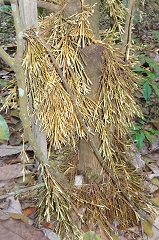
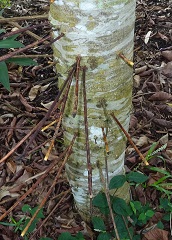 While walking around Mandai area in the afternoon on 3 December, I came across 2 trees with aerial roots. They were not the
usual aerial root trees typically from the Fig family. One of them was
Sea Gutta (Pouteria obovata). Though I had seen many of Sea Gutta
trees, this was the first one that I saw with extensive outgrowth of aerial roots from the trunk and many of the main
branches. An Internet search did not yield any report on such phenomenon on Sea Gutta.
While walking around Mandai area in the afternoon on 3 December, I came across 2 trees with aerial roots. They were not the
usual aerial root trees typically from the Fig family. One of them was
Sea Gutta (Pouteria obovata). Though I had seen many of Sea Gutta
trees, this was the first one that I saw with extensive outgrowth of aerial roots from the trunk and many of the main
branches. An Internet search did not yield any report on such phenomenon on Sea Gutta.
The other tree seen with aerial roots was Kanari Nut Tree (Canarium vulgare) found along the roadside. It took me a few days to re-identify this tree which I had last seen in 2010. The one that I saw years back did not had aerial roots. The aerial roots on the Kanari Nut Tree was sparse compared to those seen on the Sea Gutta and concentrated only on the lower part of the trunk. Nevertheless, aerial roots had been reported on Kanari Nut Tree, though it was called stilt roots instead. Stilt root is a type of aerial root.
As the name implied, aerial roots are roots originated from plant parts above the ground, usually from the trunk or branches of the plant. Besides the Fig family, other typical aerial root plants are found in the Pandan family and Orchid family. A common habitat that aerial root plants thrived is the mangrove area.
While searching for aerial root plants, I came across a report from India of a rare phenomenon of aerial roots from a Flame Tree (Delonix regia). Therefore, it was possible to find aerial roots on Sea Gutta, though a rare event.
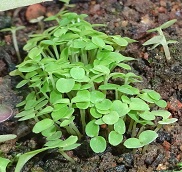
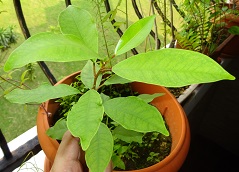
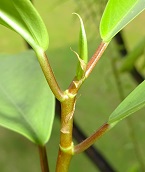
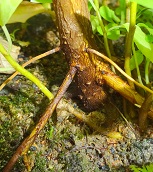 By chance, I landed with a bunch of aerial root plants in my pot. They were from the very common
Malayan Banyan (Ficus microcarpa). They started from a small pellet
of bird poo in May and its identity was confirmed in late August as the plants grow taller. Though all the seedlings started
germinating at the same time, one of them eventually stood out as the dominant plant in the pot. As this fig is very hardy
and can be "trained" to adopt different postures, I will keep them around for future experiment.
By chance, I landed with a bunch of aerial root plants in my pot. They were from the very common
Malayan Banyan (Ficus microcarpa). They started from a small pellet
of bird poo in May and its identity was confirmed in late August as the plants grow taller. Though all the seedlings started
germinating at the same time, one of them eventually stood out as the dominant plant in the pot. As this fig is very hardy
and can be "trained" to adopt different postures, I will keep them around for future experiment.
Originally, the intent was to grow a Citrus microcarpa (Calamansi) in the pot which I transferred a young seeding from another pot. Now, the fig plantlets had surrounded the small Calamansi seedling. I will leave it to nature to take its course.